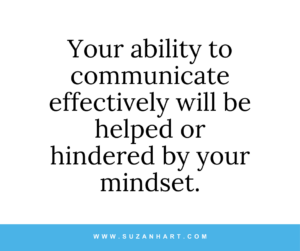Have you ever been consumed with worry and engrossed in a private conversation about what might happen? (Yes, you are talking to yourself!)
How about those moments when you are consumed with regret or fear as you relive an experience?
This week’s mastery tip: What you focus on, you find!
I remember when my company introduced a new product. Overnight, the price of the product I was selling doubled. I was concerned that the price was too high, and I secretly feared customers would object.
Although I gave the same presentation and offered more value, customers kept saying, “It is too expensive!”
Even more frustrating was that my colleagues were experiencing record sales.
The truth is that we create what we focus on! Even if it is not what we want.
So, although I wanted to make a sale, all I kept unconsciously communicating to the world was my worry about the price, and the world responded accordingly.
My words were saying buy, while my energy and body language were communicating don’t buy…“It is too expensive.”
I was unconsciously creating the outcome I did not want.
Why?…. our thoughts will always become physical form.
“Nonverbal communication is an elaborate secret code that is written nowhere, known by none, and understood by all.”
– Edward Sapir.
Whether we know it or not, you and I are continuously giving and receiving wordless signals when we interact with others.
All your nonverbal behaviors—the gestures you make, your posture, your tone of voice, and the eye contact you make—send strong messages. They can put people at ease, build trust, and draw others towards you, or they can offend, confuse, and undermine what you’re trying to convey. These messages don’t stop when you stop speaking, either. Even when you’re silent, you’re still communicating nonverbally.
Sometimes, what comes out of your mouth and what you communicate through your body language may differ.
 For example, if you say “yes” while thinking no, your listener will likely FEEL that you’re dishonest. When faced with such mixed signals, the listener must choose whether to believe your verbal or nonverbal message. Since body language is a natural, unconscious language that broadcasts your true feelings and intentions, your listener will likely choose the nonverbal message.
For example, if you say “yes” while thinking no, your listener will likely FEEL that you’re dishonest. When faced with such mixed signals, the listener must choose whether to believe your verbal or nonverbal message. Since body language is a natural, unconscious language that broadcasts your true feelings and intentions, your listener will likely choose the nonverbal message.
Your ability to communicate effectively will be helped or hindered by your mindset.
Why? Because our thoughts are the first step in communication.
Our thoughts shape our behavior, leak into our nonverbals, and influence what we say and how we say it. Brian Tracy says, “The law of concentration states that whatever you dwell upon grows. So, when I continually told myself the product was too expensive, the more that thought became part of my reality.
To improve my sales, I was required to change my mindset. When I understood and truly believed in the value of the new product pack, my thoughts changed, and I began to change my reality.
Yup, my sales soared, and I no longer heard that objection.
Here’s the secret:
- Take a moment and think of negative thoughts you regularly recall.
- Do the work to shift your belief and replace your negative thoughts with a positive statement that aligns with your goal. Please write it down.
- Repeat the new statement often and replace any negative thought with this affirmation.
- Focus on the outcome you desire.
- Take Action.
Let me know how your thoughts are influencing your reality. Are you getting what you desire?
Blessings,
Suzan
Your Fellow Super Achiever

